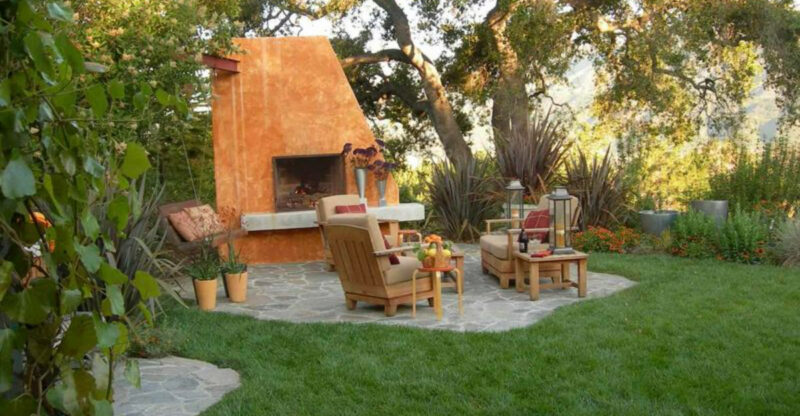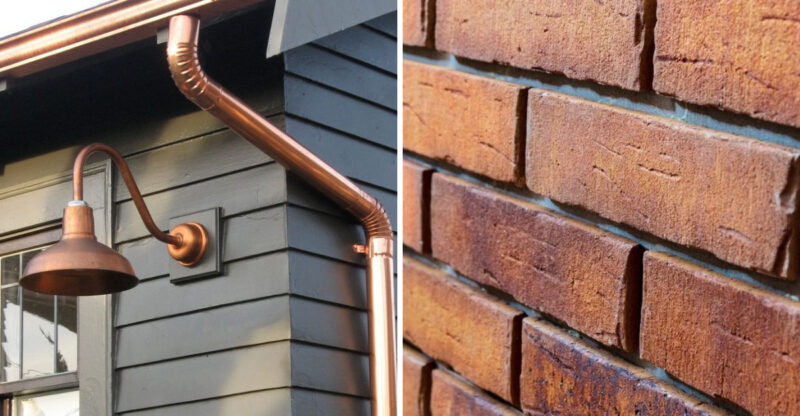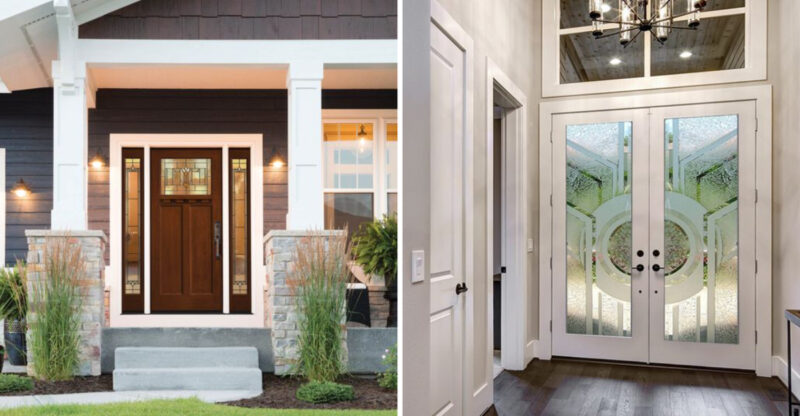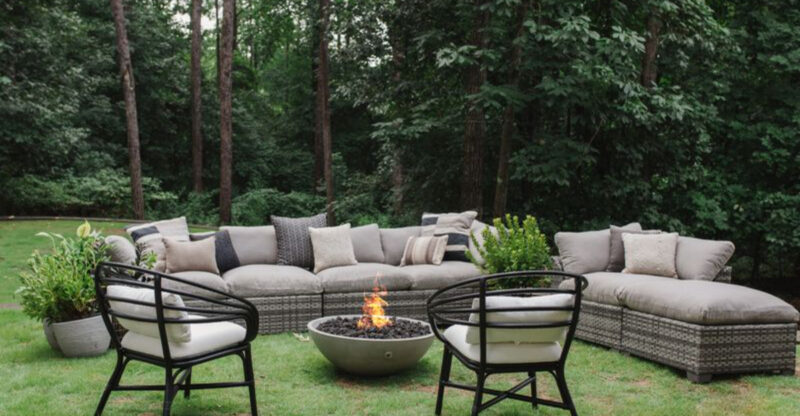21 Sustainable Front Yard Landscaping Ideas With Rocks And Mulch
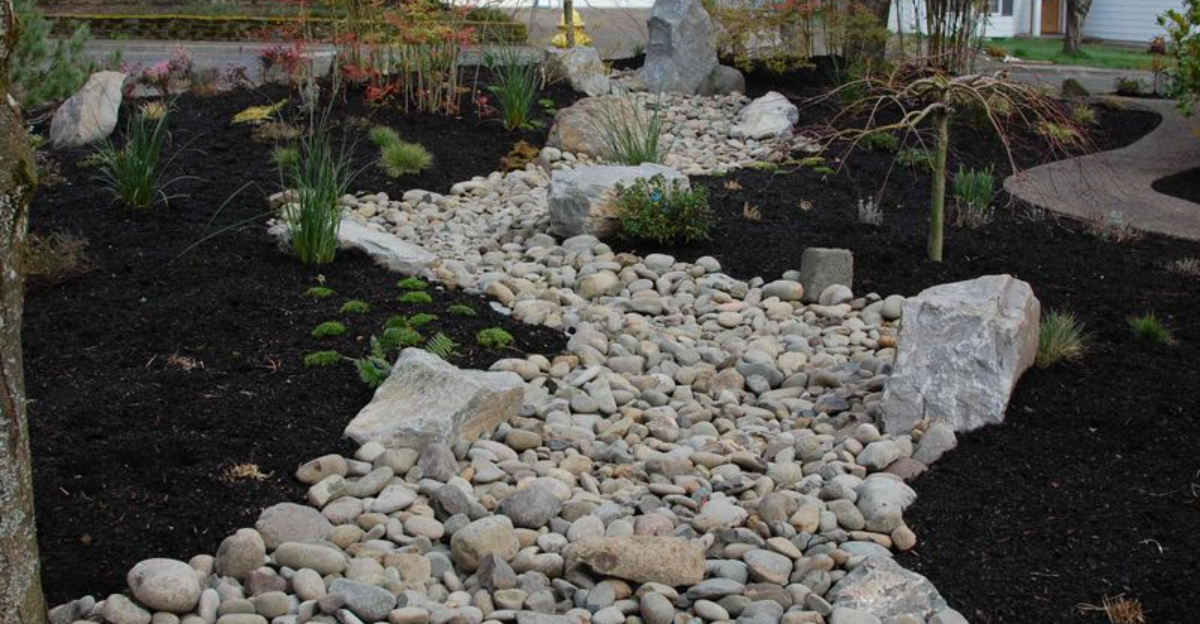
Ready to transform your front yard into a jaw-dropping showstopper without draining your wallet? Say goodbye to endless watering and mowing, rocks and mulch are here to save the day with style, savings, and serious sustainability!
Stop just dreaming about a low-maintenance oasis or a curb appeal so good it makes neighbors do a double-take. Your favorite designer is here to turn those daydreams into your new reality.
Get ready to wow the block without lifting more than a finger!
1. Zen Garden Pathways
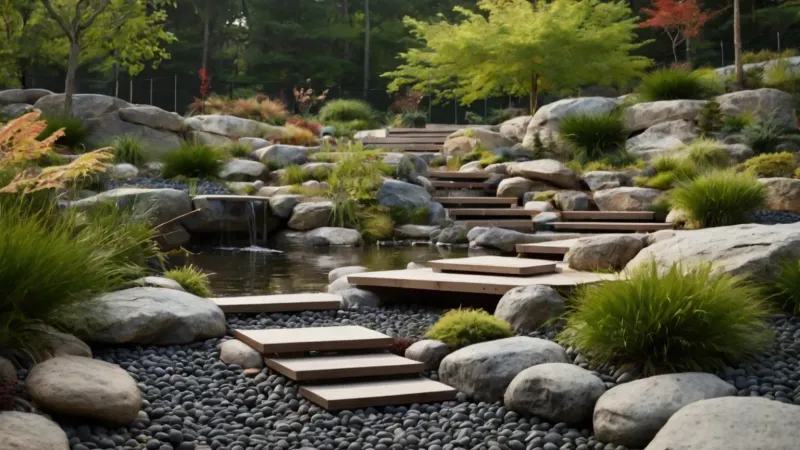
Few things say ‘welcome to my fabulous abode’ quite like winding pathways of smooth river rocks! I’ve seen homeowners transform mundane entrances into meditative journeys with strategically placed stepping stones.
The secret? Alternate sizes and colors for visual rhythm. Tuck drought-resistant grasses between rocks to soften edges.
Add solar-powered path lights for a fancy touch. They’ll also drink up sunshine all day and create magical nighttime ambiance without increasing your electricity bill.
2. Desert-Inspired Rock Garden
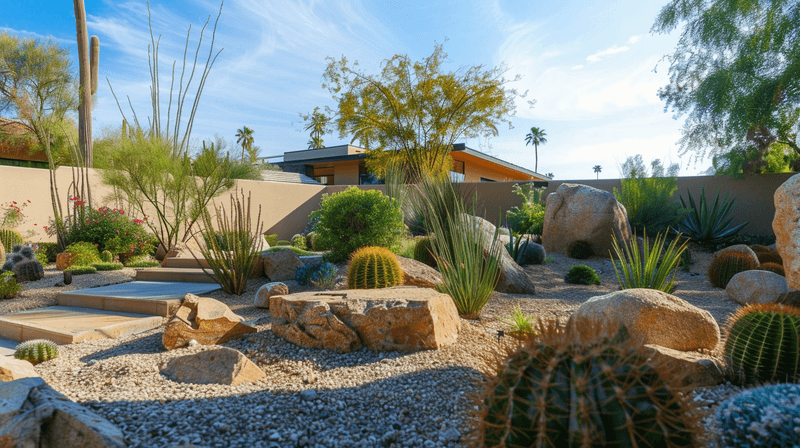
Where water is scarce, creativity blooms. A desert-inspired rock garden mimics nature’s resilience through carefully arranged boulders, pebbles, and cacti.
Start with a foundation of sand-colored gravel, then build height with larger rocks. Though some folks go overboard with identical rock placement, natural landscapes have beautiful chaos!
My clients love how their water bills plummet after installation. Plus, the occasional wildflower popping through creates those Instagram-worthy moments that make neighbors green with envy.
3. Mulched Tree Islands
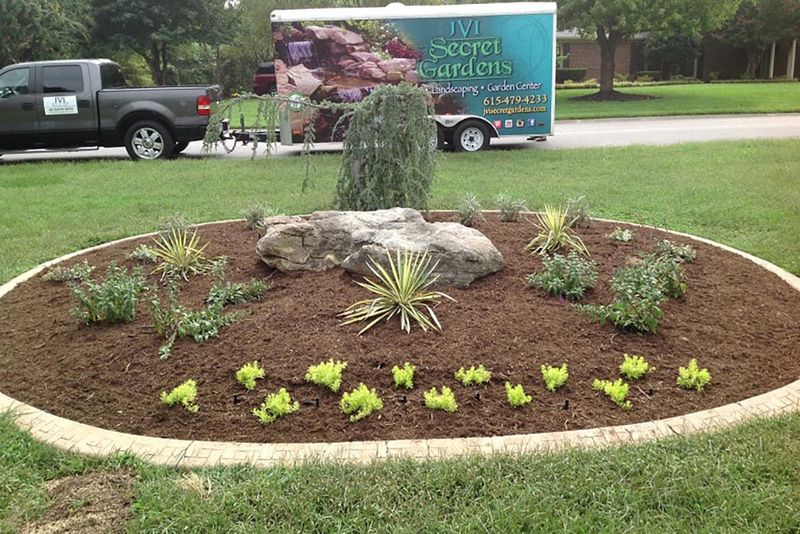
Why settle for lonely trees when you can create gorgeous mulched islands? These circular or kidney-shaped beds transform solitary trees into focal points while protecting their precious roots.
However, avoid the dreaded ‘mulch volcano’. That mound piled against tree trunks causing bark rot. Instead, spread organic mulch 2-3 inches deep in a wide circle, leaving breathing room around the trunk.
Cedar mulch smells heavenly after rain and naturally repels insects. Your trees will thank you with healthier growth and you’ll thank yourself for reducing mowing time!
4. Dry Creek Bed Feature
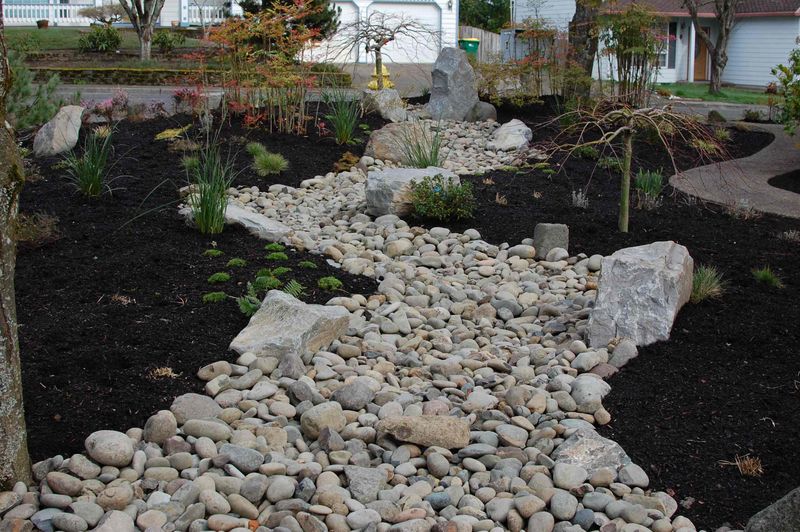
Though my clients often mistake them for actual waterways, dry creek beds are clever illusions that manage rainwater while looking spectacular! Using varied river rocks, from pebbles to cobbles, creates the impression of a natural waterway.
Install landscape fabric underneath to prevent weeds from crashing your rock party. The magic happens during rainstorms when these beds channel water away from your foundation.
This is a call for creative souls and garden dreamers. Place larger boulders along the edges and plant moisture-loving natives nearby. The result? A low-maintenance masterpiece that works harder than it looks!
5. Rock Mulch Border Gardens

Forget boring lawn edges! Rock mulch borders create definition while eliminating those tedious trim sessions with weed whackers. I’ve transformed countless front yards with this simple technique.
Layer smaller rocks (¾-inch diameter works beautifully) about 3 inches deep along garden beds or walkways. The mix of rock colors and plant foliage brings drama without the drama of upkeep. Thank me later when your garden’s stealing all the spotlight!
Though white marble chips look stunning initially, they show dirt quickly. Instead, consider regional stone that complements your home’s exterior for that ‘meant-to-be-together’ aesthetic.
6. Succulent Rock Gardens
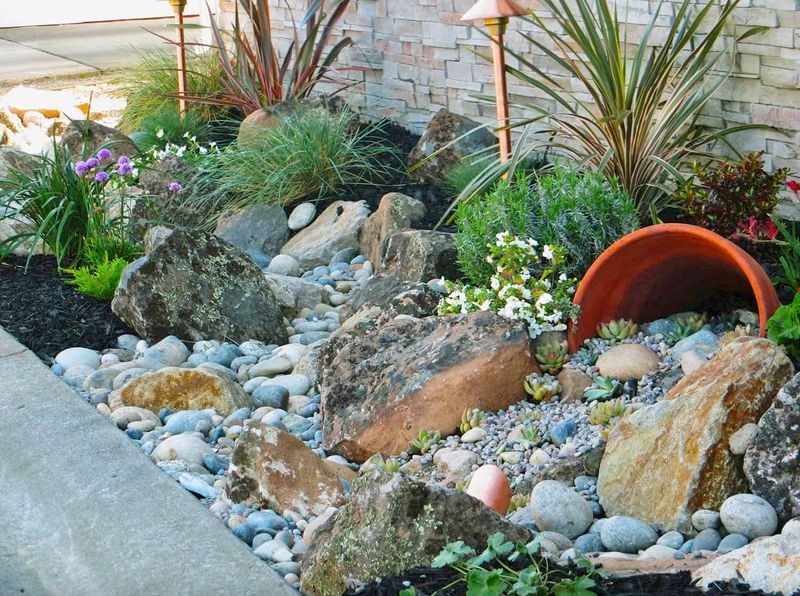
When it comes to surviving a zombie apocalypse, succulents would be the last plants standing! Pair these water-wise warriors with rocks for a maintenance-free symphony of textures.
Start with a foundation of well-draining soil mixed with small gravel. Arrange larger rocks to create microclimates, morning sun here, afternoon shade there.
My favorite trick? Plant succulents in clusters of odd numbers (3, 5, 7) for that designer look.
Their sculptural forms against rock backgrounds create living art. It evolves seasonally without demanding constant attention or precious water resources.
7. Rain Garden With Rock Accents

Why let good rainwater escape to sewers when your plants could be having a spa day? Rain gardens collect runoff in stylish depressions filled with river rocks and water-loving plants.
The secret sauce is layering. Larger rocks at the basin’s center create dramatic splashes during downpours, while smaller pebbles around edges filter debris.
Though many homeowners fear mosquito breeding grounds, properly designed rain gardens drain within 24 hours.
My clients adore how these gardens transform storm events into visual spectacles while reducing flooding and pollution. Mother Nature gives standing ovations for this sustainable solution!
8. Terraced Rock Walls
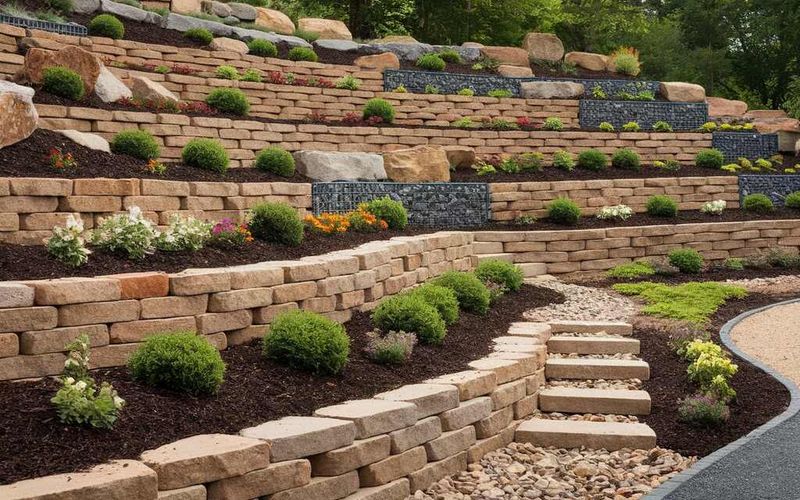
Sloped yards become stunning showcases with terraced rock walls. Instead of fighting gravity, these stacked stone structures create level planting areas while preventing erosion.
Though beginners often stack rocks randomly, professional-looking walls have larger, flatter stones at the bottom with each layer stepping slightly inward.
The spaces between rocks? Perfect pockets for drought-tolerant groundcovers that cascade dramatically.
Does your property have natural stone? Incorporate it for authentic regional character. Your wallet will thank you, and environmentalists will applaud your resource conservation.
Plus, these walls become warmer microclimates for plants that appreciate extra heat!
9. Mulched Pollinator Gardens

Want your front yard buzzing with life? Mulched pollinator gardens attract butterflies, bees, and hummingbirds while reducing water usage!
Start with 3 inches of organic mulch (shredded leaves work wonders) surrounding native flowering plants. Though pine straw looks rustic, it decomposes slowly and adds acidity perfect for azaleas and blueberries.
My clients often report neighborhood children stopping to watch butterfly activity. These gardens create learning opportunities while reducing maintenance.
The mulch suppresses weeds and retains moisture so you can spend weekends enjoying life instead of pulling unwanted plants!
10. Japanese-Inspired Rock Arrangements
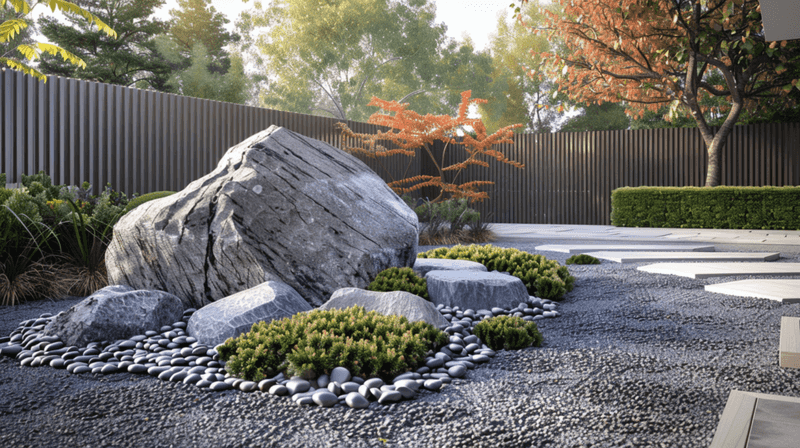
Just imagine that rocks could tell stories and trust me, Japanese-inspired arrangements would be poetry. These thoughtfully placed stone groupings create focal points that change with light and seasons.
The magic lies in odd numbers and asymmetry. Three rocks of varying heights positioned to represent mountains, with the tallest slightly offset. Surround them with fine gravel that you can rake into meditative patterns.
Though many homeowners overthink this style, simplicity is key. One striking arrangement commands more attention than scattered stones.
Add a single Japanese maple or ornamental grass nearby for that perfect balance between structure and movement.
11. Crushed Granite Pathways

Forget pricey pavers. Crushed granite pathways offer affordable elegance with that satisfying crunch underfoot. Unlike concrete, these permeable paths allow rainwater to seep through, reducing runoff and replenishing groundwater.
The installation secret? Tamped layers with steel edging to maintain crisp lines. Though some designers choose stark white granite, I prefer warmer tones. They don’t blind you on sunny days or show every fallen leaf.
For extra sustainability points, source locally quarried materials to reduce transportation emissions. Your pathway will weather gracefully over time, developing character like fine wine rather than cracking like concrete!
12. Gabion Rock Features
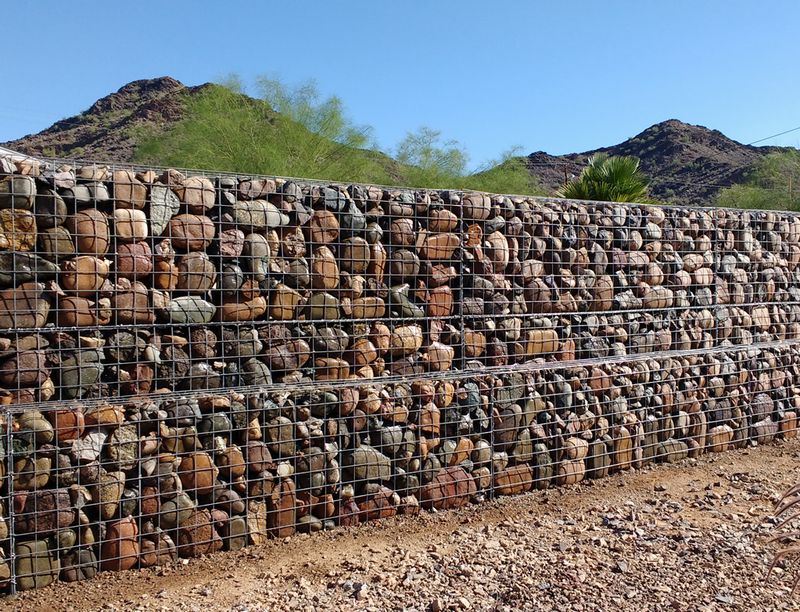
Industrial chic meets ecological function with gabion features. These wire cages filled with rocks create stunning retaining walls, benches, or decorative elements that withstand weather extremes.
The beauty lies in versatility. Fill with local stone, recycled concrete, or even glass for unique visual effects. Though many installers use uniform rocks, mixing sizes and colors creates more dynamic patterns.
My customers love how these structures allow beneficial insects to create homes in the crevices.
For extra drama, install solar-powered lights inside the gabions to create magical evening glows Watch the magic happen as they transform your front yard into an artistic landscape.
13. Rubber Mulch Play Areas
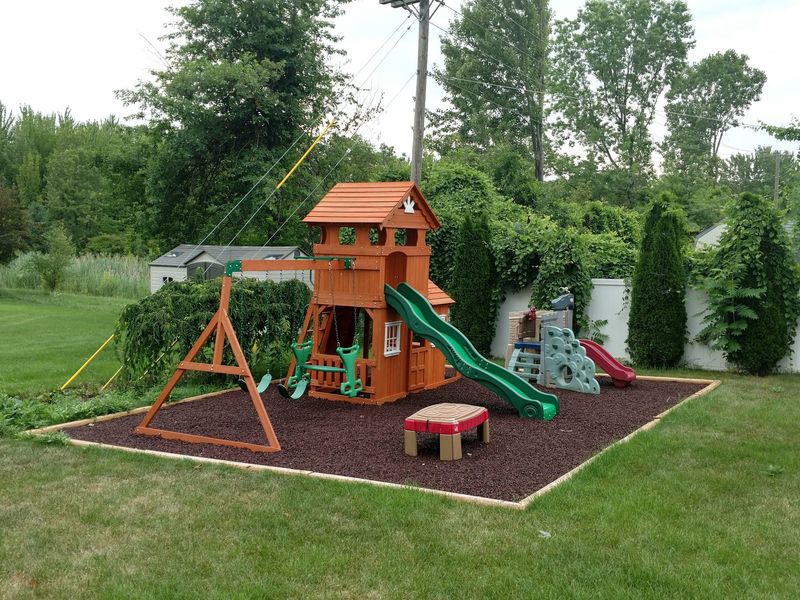
Who says front yards can’t be functional? Rubber mulch creates safe play zones for kiddos while maintaining curb appeal! Made from recycled tires, this colorful alternative stays put during storms unlike traditional mulch.
Though purists prefer natural materials, rubber mulch lasts up to 10 years without replacement. The installation trick? Create defined borders with rocks or timber to contain the material.
For neighborhood harmony, choose earth tones rather than primary colors. Your kids get a safe play surface, you get reduced maintenance, and hundreds of tires stay out of landfills.
That’s what I call a triple win for sustainable living!
14. Mulched Native Plant Berms
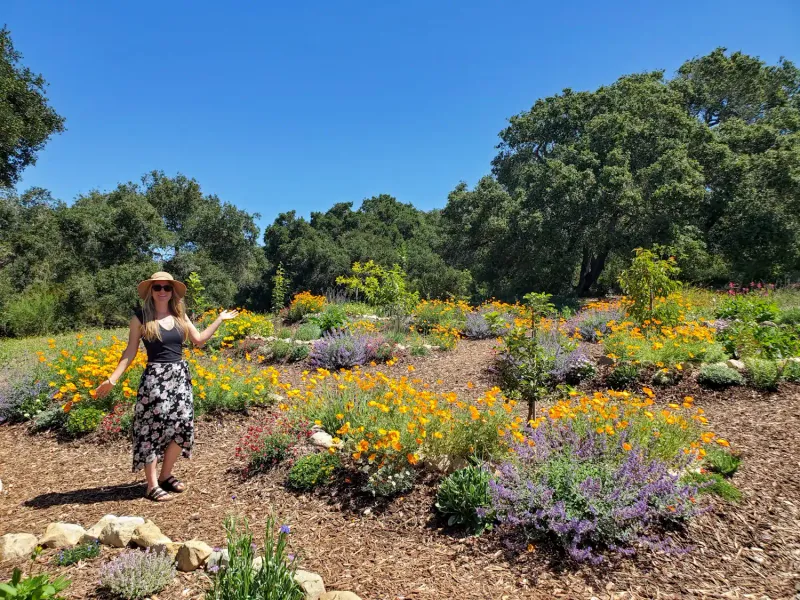
Flat yards? Boring! Mulched native plant berms add dimension while creating microclimates for diverse plant communities.
Build gentle mounds of soil (2-3 feet high works well) in curved formations. Though many landscapers use expensive imported soil, I recommend mixing your existing dirt with compost for better plant nutrition.
Cover with 3 inches of shredded hardwood mulch and plant native species appropriate for each position, moisture-lovers at the base, drought-tolerant at the peak.
The elevation changes create visual interest while the mulch reduces water needs and suppresses weeds. Your yard becomes a miniature ecosystem!
15. Rock-Lined Rain Barrels
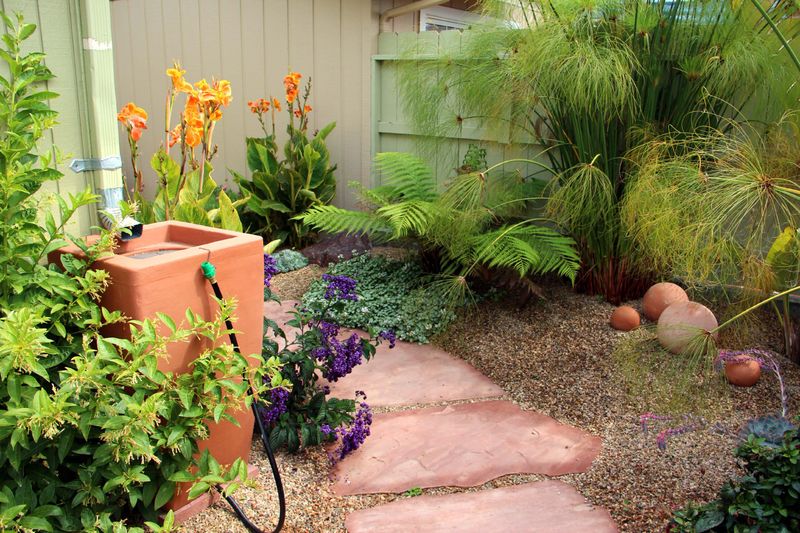
Why waste precious rainwater when you can capture it stylishly? Rock-lined rain barrels collect roof runoff while creating attractive focal points.
The designer secret? Surround utilitarian barrels with decorative rocks and water-loving plants to create mini-oases. Though many homeowners hide barrels behind buildings, showcasing them celebrates sustainable practices!
Install overflow systems that direct excess water to nearby gardens through rock-lined channels. During summer droughts, you’ll have free water for thirsty plants while your neighbors drag hoses.
Plus, those rocks prevent erosion from barrel overflow during heavy downpours.
16. Permeable Rock Driveways
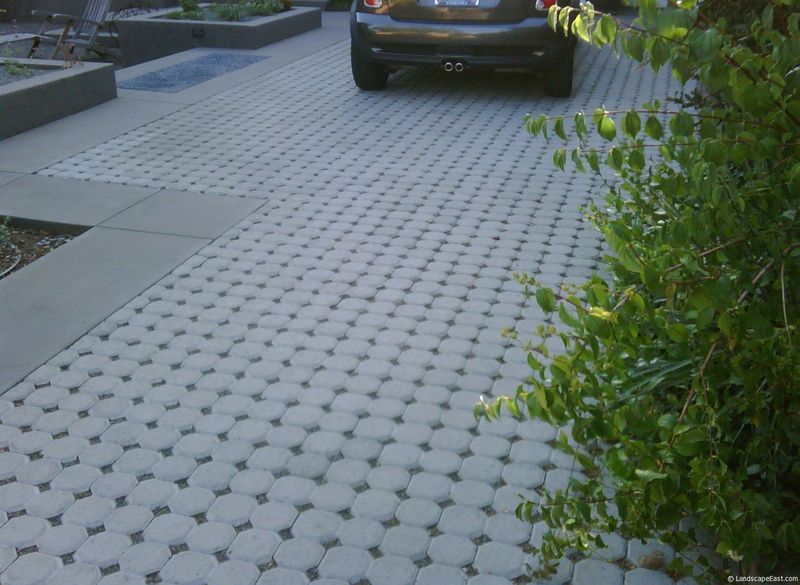
Concrete driveways are so last century. Permeable rock driveways allow rainwater to filter through rather than creating environmentally damaging runoff.
The installation magic happens in layers. Geotextile fabric first, then progressively smaller rock layers from bottom to top. Though crushed stone looks utilitarian alone, adding decorative borders of contrasting rock elevates the design.
If you’re worried about snow removal, fear not! These driveways actually reduce ice buildup since water drains through rather than pooling on the surface.
Your local watershed will thank you for reducing pollution while your neighbors admire your eco-chic approach to vehicle parking!
17. Pine Straw Mulch Beds

Southern charm meets practical sustainability with pine straw mulch beds! These rustic-looking areas retain moisture while adding warm color to your landscape.
Unlike wood mulch that floats away during heavy rains, pine needles interlock to stay in place. Though skeptics worry about acidity, the effect is minimal and actually beneficial for acid-loving plants like azaleas and rhododendrons.
My favorite application technique? Layer 3-4 inches deep and refresh annually with a thin new layer. The needles break down slowly, improving soil structure over time.
Bonus tip: Add a visual pop by lining your beds with medium-sized river rocks, creating sharp, tidy borders between mulch and lawn.
18. Meditation Rock Circles

Transform unused lawn spaces into spiritual havens with meditation rock circles. These simple arrangements create peaceful focal points while eliminating grass maintenance.
The design approach? Select rocks of varying heights and arrange them in a perfect circle with comfortable spacing for seating. Though large boulders create drama, smaller stones allow for easier rearrangement.
Fill the interior with crushed stone or fine gravel that can be raked into patterns for added meditative practice. Come on, who needs a yoga studio when your front yard offers spiritual connection?
19. Cocoa Shell Mulch Gardens

Chocolate lovers, rejoice! Cocoa shell mulch brings rich color and heavenly scent to front yard gardens while putting food industry byproducts to good use.
The application is straightforward, just spread 2 inches around plants, avoiding direct contact with stems. Though the chocolate aroma fades after a few weeks, the rich brown color lasts much longer.
If you have four-legged friends, consider alternative mulches as cocoa shells contain compounds toxic to dogs. For everyone else, this mulch offers excellent weed suppression while slowly adding nutrients to soil as it breaks down.
Your garden smells delicious while looking polished!
20. Rock-Edged Herb Spirals
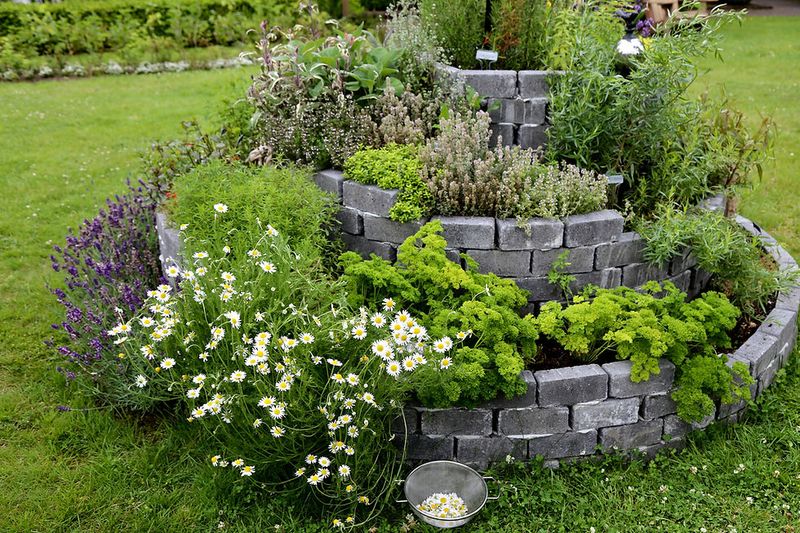
Why grow herbs in boring rows when you can create magical spirals? These rock-edged vertical gardens create multiple microclimates in minimal space.
The construction begins with a circular base of larger rocks, spiraling upward to create a cone-shaped mound. Though many gardeners use uniform stones, mixing sizes and textures creates more natural aesthetics.
The genius lies in plant placement, moisture-loving herbs like mint at the bottom, Mediterranean herbs like rosemary at the top. Mulch between plants prevents water loss while the rocks absorb heat, extending your growing season.
Your cooking improves while your front yard becomes a conversation starter!
21. Lava Rock Heat Islands
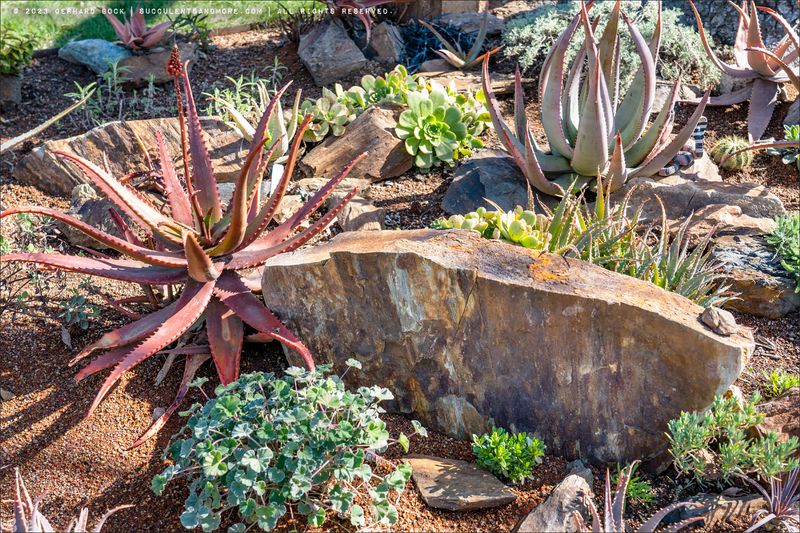
Heat-loving plants deserve special treatment. Lava rock islands create perfect microclimates for plants that appreciate extra warmth while adding dramatic red-black texture to landscapes.
Unlike decorative rocks that merely look pretty, lava rock serves a thermal function. The porous material absorbs daytime heat and releases it slowly overnight, protecting tender plants from temperature drops.
Though installation is straightforward (3-inch layer over landscape fabric), the magic happens in plant selection. Desert plants like agave and yucca thrive in these warm spots, creating stunning architectural elements.
Your garden microclimate engineering will impress even the geekiest plant enthusiasts!

